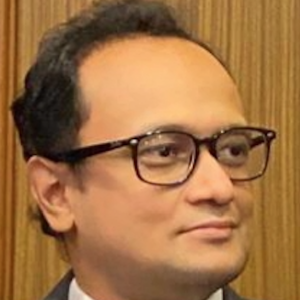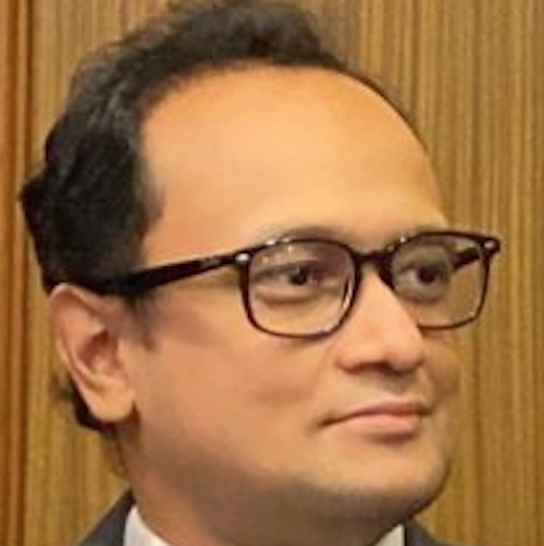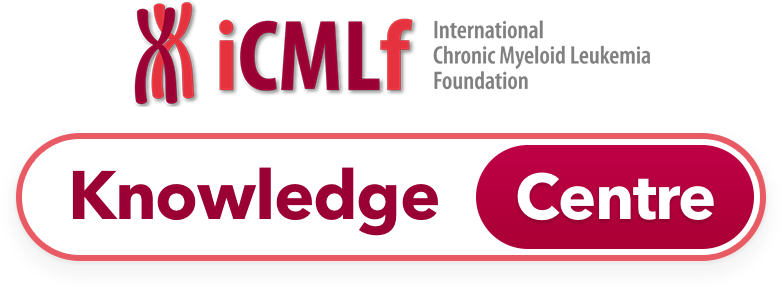 Professor Meinolf Suttorp
Professor Meinolf Suttorp
(Germany)
Pediatric CML
 Professor Nirmalya Roy Moulik
Professor Nirmalya Roy Moulik
(India)
Chair's Overview
Professor Meinolf Suttorp
Pediatric Hematology – Oncology
Medical Faculty
Technical University
Dresden, Germany
Dr Nirmalya Roy Moulik
Professor of Paediatric Oncology
Tata Memorial Hospital
Mumbai, India
Index
Click to jump to section
1. Difference Between Adult and Pediatric CML
2. Predisposition and Genetic Factors in Pediatric CML
3. Management of Pediatric CML in the Resource-Constrained Setting
4. Impact of Tyrosine Kinase Inhibitors (TKIs) on Growth and Endocrine Function in Children with CML
5. Treatment Recommendations for CML – Chronic Phase
6. Treatment Recommendations in Pediatric CML Blast Phase
7. Treatment Free Remission in Pediatric CML
8. Tyrosine Kinase Inhibitor Toxicity in Pediatric CML
9. Parenting in Children with CML
Difference Between Adult and Pediatric CML

Dr Deepam Pushpam
Assistant Professor
Department of Medical Oncology
All India Institute of Medical Sciences
Delhi, India
Predisposition and Genetic Factors in Pediatric CML

Professor Markus Metzler
Faculty of Medicine
Friedrich-Alexander University
Erlangen-Nurnberg Germany
Management of Pediatric CML in the Resource-Constrained Setting

Dr Nirmalya Roy Moulik
Professor, Pediatric Oncology
Tata Memorial Hospital
Mumbai, India
Impact of Tyrosine Kinase Inhibitors (TKIs) on Growth and Endocrine Function in Children with CML

Professor Meinolf Suttorp
Pediatric Hematology – Oncology
Medical Faculty
Technical University Dresden, Germany
Treatment Recommendations for Pediatric CML - Chronic Phase

Professor Frédéric Millot
Chairman of the CML committee of the I-BFM Study Group
Coordinator of the International Registry of Childhood CML
CHU de Poitiers
Poitiers, France
Treatment recommendations in pediatric CML blast phase

Dr Stephanie Sembill
Department of Hematology and Oncology
University Hospital
Erlangen, Germany
Treatment Free Remission in Pediatric CML

Professor Nobuko Hijiya
Herbert and Florence Irving Professor
Section Head of Pediatric Oncology
Pediatric Hematology/Oncology/Stem Cell Transplant
Columbia University Irving Medical Center
New York, NY, USA
Tyrosine kinase inhibitor toxicity in pediatric CML

Dr Maaike Luesink
Pediatric Oncologist
Princess Máxima Center for Pediatric Oncology
Utrecht, The Netherlands
Parenting in children with CML

Professor Meinolf Suttorp
Pediatric Hematology – Oncology
Medical Faculty
Technical University Dresden, Germany
Discussion
Do you have any questions, or comments for the speakers, or community?
Leave your comments below and we will contact the presenter for a reply.
To prevent spam all comments will be forwarded to an admin who will approve the comments and arrange a reply if appropriate.


do you have any reccomendations for hydroxyurea use in case of ASYMPTOMATIC hyperleukocytosis in newly diagnosed CML in children? I know ELN guidelines for adult CML say to use a short course for symptomatic hyperleukocytosis.
The question posed may concern a case with a suspected diagnosis of CML and hyperleukocytosis but no clinical problems arising from leukostasis.
Hydroxyurea (HUS) is a well-tolerated oral option for effective reduction of the white cell count (WBC) to be considered in all types of leukemias (ALL, AML, CML) presenting with hyperleukocytosis (by definition >100 000 WBC/µL) +/- clinical signs of leukostasis (CNS-symptoms, respiratory symptoms, blurred vision, hearing problems, priapism in males). Together with I.V. hydration, the drug can be orally administered immediately and continued until the WBC is in an acceptable range.
Imatinib should be administered only after a diagnosis of Philadelphia-positive CML is confirmed. While this is possible in some hospitals by FISH technique rapidly within 24 hours, a classical approach by karyotyping with Giemsa banding may require 3 to 5 to 7 days.
From a global perspective, the posed question can only be answered within the context of the given socio-economic background and the resources available in a hospital or country.
A) If imatinib is not available, therapy with hydroxyurea (HUS, 50 mg/kg daily, in 4 divided doses, maximum daily dose 4 g) should start immediately independent from the WBC with the intention to achieve a hematological response. Increased levels of uric acid have been observed in older patients mostly of male sex when taking HUS, but this should not play a role in pediatrics. Allopurinol is used to minimize complications associated with elevated uric level. Usually, it takes 36-48 hours with HUS to reduce the circulating WBC by approximately 20%.
B) If imatinib therapy is an option (IMA 300 mg/sqm body surface, once daily, maximum daily dose 400 mg) therapy should start once the diagnosis of Ph-positive CML is confirmed. Usually, it takes 1 week with imatinib to reduce the circulating WBC by approximately 20%.
With a mean WBC of 250.000/µl in CML-CP at diagnosis, presence of hyperleukocytosis is more or less the rule in pediatric CML. In large registries, data on pediatric CML-CP show no hyperleukocytosis (WBC <100.000/µl) in only one third of newly diagnosed patients. Problems from leukostasis were observed only if the WBC exceeded 200.000/µl and affected about 10% of the patients with a newly diagnosed pediatric CML-CP [Millot F, et al. 2005; Adler R, et al. 2008, Kurosawa H, et al. 2016]. These figures -may be due to higher case numbers analyzed- differ considerably from a frequently cited and much higher reported 60% rate of leukostasis observed in 6 out of 10 pediatric CML patients described in the older literature [Rowe JM, et al. 1984].
Thus, the height of the WBC and the time necessary to confirm the diagnosis of Ph-positive CML play the major role when deciding on the initial treatment.
There are no prospective data on the time point when imatinib treatment was initiated and whether or not it was preceded by a short course of hydroxyurea in pediatric CML. From my personal experience, I would recommend for cases without signs of leukostasis:
i) watchfull waiting with hydration in cases with a WBC <200.000/µl only and if the results of Philadelphia-chromosome positivity or BCR::ABL1 PCR will be obtained within 5 days. Otherwise start HUS to minimize a very low but not negligible risk of leukostasis arising while waiting for laboratory results (e.g. priapism at night in adolescent boys).
ii) In cases with WBC >200.000/µl start HUS and hydration.
As soon as CML is confirmed and imatinib is available, the next questions arise: iii) Should therapy by HUS be continued until the WBC is close to the normal range again or iv) should a switch to imatinib be undertaken independently from the current WBC? No definitive, general recommendation applicable around the globe can be given for pediatric CML:
iii) HUS is a possible approach for reducing the daily costs of treatment but more or less represents “white cell cosmetics” only, while
iv) imatinib is much more expensive but causally acting against the BCR::ABL1 fusion protein. In line with recommendations for adult CML, in pediatric CML it is not necessary to bring the WBC down to normal levels before starting imatinib [Cortes J, et al. 2012].
It should be stressed, however, that discontinuation of HUS should be performed by a stepwise dose reduction schedule over one week in parallel with start of TKI therapy at full dose. This will avoid a rebound increase of WBC frequently observed if HUS is stopped abruptly.
Hoping that my answer is helpful in some way.
Kind regards
Professor Meinolf Suttorp
The question posed may concern a case with a suspected diagnosis of CML and hyperleukocytosis but no clinical problems arising from leukostasis.
Hydroxyurea (HUS) is a well-tolerated oral option for effective reduction of the white cell count (WBC) to be considered in all types of leukemias (ALL, AML, CML) presenting with hyperleukocytosis (by definition >100 000 WBC/µL) +/- clinical signs of leukostasis (CNS-symptoms, respiratory symptoms, blurred vision, hearing problems, priapism in males). Together with I.V. hydration, the drug can be orally administered immediately and continued until the WBC is in an acceptable range.
Imatinib should be administered only after a diagnosis of Philadelphia-positive CML is confirmed. While this is possible in some hospitals by FISH technique rapidly within 24 hours, a classical approach by karyotyping with Giemsa banding may require 3 to 5 to 7 days.
From a global perspective, the posed question can only be answered within the context of the given socio-economic background and the resources available in a hospital or country.
A) If imatinib is not available, therapy with hydroxyurea (HUS, 50 mg/kg daily, in 4 divided doses, maximum daily dose 4 g) should start immediately independent from the WBC with the intention to achieve a hematological response. Increased levels of uric acid have been observed in older patients mostly of male sex when taking HUS, but this should not play a role in pediatrics. Allopurinol is used to minimize complications associated with elevated uric level. Usually, it takes 36-48 hours with HUS to reduce the circulating WBC by approximately 20%.
B) If imatinib therapy is an option (IMA 300 mg/sqm body surface, once daily, maximum daily dose 400 mg) therapy should start once the diagnosis of Ph-positive CML is confirmed. Usually, it takes 1 week with imatinib to reduce the circulating WBC by approximately 20%.
With a mean WBC of 250.000/µl in CML-CP at diagnosis, presence of hyperleukocytosis is more or less the rule in pediatric CML. In large registries, data on pediatric CML-CP show no hyperleukocytosis (WBC <100.000/µl) in only one third of newly diagnosed patients. Problems from leukostasis were observed only if the WBC exceeded 200.000/µl and affected about 10% of the patients with a newly diagnosed pediatric CML-CP [Millot F, et al. 2005; Adler R, et al. 2008, Kurosawa H, et al. 2016]. These figures -may be due to higher case numbers analyzed- differ considerably from a frequently cited and much higher reported 60% rate of leukostasis observed in 6 out of 10 pediatric CML patients described in the older literature [Rowe JM, et al. 1984].
Thus, the height of the WBC and the time necessary to confirm the diagnosis of Ph-positive CML play the major role when deciding on the initial treatment.
There are no prospective data on the time point when imatinib treatment was initiated and whether or not it was preceded by a short course of hydroxyurea in pediatric CML. From my personal experience, I would recommend for cases without signs of leukostasis:
i) watchfull waiting with hydration in cases with a WBC <200.000/µl only and if the results of Philadelphia-chromosome positivity or BCR::ABL1 PCR will be obtained within 5 days. Otherwise start HUS to minimize a very low but not negligible risk of leukostasis arising while waiting for laboratory results (e.g. priapism at night in adolescent boys).
ii) In cases with WBC >200.000/µl start HUS and hydration.
As soon as CML is confirmed and imatinib is available, the next questions arise: iii) Should therapy by HUS be continued until the WBC is close to the normal range again or iv) should a switch to imatinib be undertaken independently from the current WBC? No definitive, general recommendation applicable around the globe can be given for pediatric CML:
iii) HUS is a possible approach for reducing the daily costs of treatment but more or less represents “white cell cosmetics” only, while
iv) imatinib is much more expensive but causally acting against the BCR::ABL1 fusion protein. In line with recommendations for adult CML, in pediatric CML it is not necessary to bring the WBC down to normal levels before starting imatinib [Cortes J, et al. 2012].
It should be stressed, however, that discontinuation of HUS should be performed by a stepwise dose reduction schedule over one week in parallel with start of TKI therapy at full dose. This will avoid a rebound increase of WBC frequently observed if HUS is stopped abruptly.
Hoping that my answer is helpful in some way.